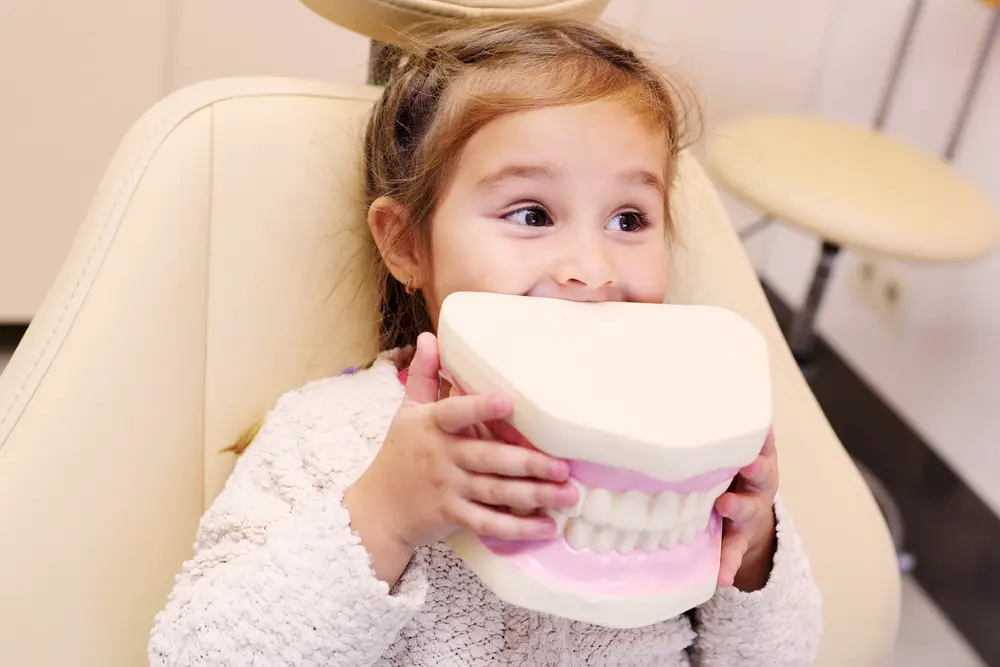
Blog Summary:
This blog provides a practical and supportive guide for parents preparing their child for their first cavity filling. It covers what cavities look like in kids, why they form, how pediatric dentists treat them, and how to help your child feel more at ease.
Highlights:
- What cavities look like in kids: Cavities often appear as white chalky spots, brown or black marks, or visible holes. Children may also report sensitivity or tooth pain even if the cavity isn’t visible.
- What causes cavities in kids: Poor brushing habits, excess sugar and starch intake, lack of fluoride, mouth breathing, and certain medical conditions or medications can all contribute to tooth decay.
- How pediatric dentists fill cavities: Dentists numb the area with a child-safe anesthetic, gently remove decay, and fill the hole with a suitable material. The process is safe, quick, and designed for small mouths and growing teeth.
- How to prepare your child: Stay calm yourself, validate their feelings, explain the procedure in a kid-friendly way, and choose a pediatric dentist who specializes in treating children gently and effectively.
- Top parent FAQs answered: The blog answers common questions like how to prevent cavities, whether fillings hurt, what happens if cavities are untreated, how dentists fill them, and why they occur in children.
Preparing your child for a cavity filling can be a nerve-wracking experience as a parent. After all, getting a filling is rarely fun. But, as we all know, neither is having a cavity caused by tooth decay! But you’re not alone.
To help you get your child ready for their first cavity filling, we put together this guide. It’s full of information you can share with your child, and tips for you to help them feel at ease, calm, and confident about the procedure. The bottom line is this: pediatric cavity fillings are fairly common, and the procedure to fill cavities is, thankfully, usually fairly routine. With the right prep, your kiddo can breeze through it all like a true dental superhero!
What do cavities look like in kids’ teeth?
Cavities in children often are so small you might not even be able to see them without a dental exam! In cases where you can see them, they usually look like one of the following:
- White chalky spots on the enamel (demineralization)
- Brown or black spots that don’t brush away
- Visible holes or pitting in the teeth
Sometimes, even when cavities aren’t visible, your little one will complain of tooth pain, especially when chewing, or sensitivity to hot, cold, or very sweet foods.
What is a cavity, anyway?
A cavity is caused by bacteria in the mouth. Without proper oral hygiene, these bacteria create acids from unhealthy foods such as sugary or processed foods.. The acid eats away at teeth until eventually a hole is formed. This hole is called a cavity.
Cavities in a child’s mouth are very common. In fact, the CDC says, “Among children aged 6 to 8 years, over half (52%) have had a cavity in their primary (baby) teeth. Children from low-income families are twice as likely to have untreated cavities as higher-income children. Among adolescents aged 12 to 19, more than half (57%) have had a cavity in their permanent teeth.”
When a tooth is fractured or damaged due to decay or trauma, dental fillings can replace and restore the tooth’s structure. No one wants to hear that they have a cavity; however, cavity filling is a routine procedure that can fix the tooth, remove the decay, and help the child feel more comfortable.
Looking for information on how to explain a cavity to a kid?: “A cavity is like a tiny hole in your tooth that happens when ‘sugar bugs’ (bacteria) make your tooth sick. But don’t worry! The dentist can fix it with a special material that makes your tooth strong again!”
What causes cavities in children?
Cavities are usually formed in a child’s teeth when they are not properly brushed. Some other common causes include
- Consuming too many sugars and starches
- Public water supply without fluoride
- High levels of the bacteria that cause cavities
- Less saliva flow than normal
- Mouth breathing
- Medical conditions or medications
- Poor oral care routines or products
How do dentists fill cavities in toddlers and children?
Baby teeth are filled much the same way an adult tooth is, so if you are familiar with that process, it’s a good place to start. If you are new to the idea of filling a cavity, the procedure for filling a child’s cavity is fairly straightforward:
- First, the dentist removes the decay,
- Next, the dentist fills the hole with composite or metal material,
- Lastly, the dentist adheres the filling material to the tooth.
Your dentist will work hard to make the procedure as comfortable as possible. A local anesthetic is used to numb the area via a small needle prior to the procedure. A topical anesthetic jelly is applied first to the child’s cheek and gums so they will not feel the needle. Dentists may also offer nitrous oxide to help children relax during the filling.
So, as you can see, the process is similar to what you may have seen for yourself. There are a few differences in what happens when a child gets a filling:
- A pediatric dentist will use pain management that is safe for children
- The dentist will use tools that are specially sized to treat cavities in baby teeth and small mouths
- The dentist will assess your child’s situation and determine which filling is best suited to them specifically (is the filling in a baby tooth that will fall out soon, or in a permanent adult tooth?)
Tips for preparing a child for cavity filling
As you can see, getting a filling is an easy procedure, but it does tend to cause some anxiety. Here are a few ways that you can help them feel more comfortable.
Stay calm yourself
If you are nervous about the dentist yourself, make sure you don’t project that anxiety onto your child. To put it simply, if you show them you are nervous, it’s an invitation for them to feel the same way!
Understanding Your Child’s Fear and Anxiety
That said, it’s also important to recognize and legitimize your child’s anxiety. Remember that this is a new experience for them, and that new experiences are full of mystery. They may not have been to the dentist many times, so this might be a place full of relatively new sights, sounds, and even smells.
Some pediatric dentistry offices, like The Super Dentists, are experts at calming little nerves. You can help, too. Perhaps let your child bring a favorite comfort item (like a teddy bear).
Consider the advice that Today’s Parent Magazine suggests:
“That bright light the dentist shines on your kid’s mouth might bother her eyes and could make her want to bolt. Bring along a pair of fun sunglasses, or call ahead to see if your dentist already provides them.”
Explain the procedure
While sunglasses are a fun tool, we suggest that you DON’T keep your child in the dark about what they should expect. Talk them through the procedure–though be careful of “scary” words. If they want specifics, we suggest that you “Let the dentist answer the detailed or complex questions your child may have. Pediatric dentists learn the non-threatening way to explain procedures to children in an easy-to-understand language.”
Choose the right dentist
Picking the right dentist is the very best way to prepare your child for cavity filling. The Super Dentists is the leading pediatric dental services provider in San Diego, and we boast comprehensive experience in working with kids and parents alike.
We’re here to make the entire process of treating kids’ teeth with cavities as easy and comfortable as possible for everyone involved, especially your kiddo! At the end of the day, we want to be here to help prevent cavities in kids, if possible, with the right care tips and advice, but we get that sometimes, that’s just not possible. In those instances where cavities have developed, we happily fill them, making the entire experience as fun, painless, and empathetic as we can!
Are you concerned about gingivitis or cavities in your child? Schedule a visit at a The Super Dentists location near you!
FAQs About Pediatric Cavity Fillings & Cavities in Kids
How can I prevent cavities in kids?
Good brushing and flossing habits, a healthy diet, and regular checkups with your pediatric dentist are the best ways to keep cavities away.
What happens if a cavity in a baby tooth is left untreated?
It can lead to bigger problems like pain, swelling, infections, and damage to permanent teeth underneath.
Do pediatric cavity fillings hurt?
Not usually. Pediatric dentists use gentle numbing techniques and fun distractions to make the experience easy for kids.
How do pediatric dentists fill cavities?
They gently remove the decay, clean the area, and fill the space with a safe material to protect the tooth and stop the cavity from getting worse.
What causes cavities in kids?
Cavities are caused by bacteria in the mouth that feed on sugars and starches, producing acids that damage tooth enamel over time.











